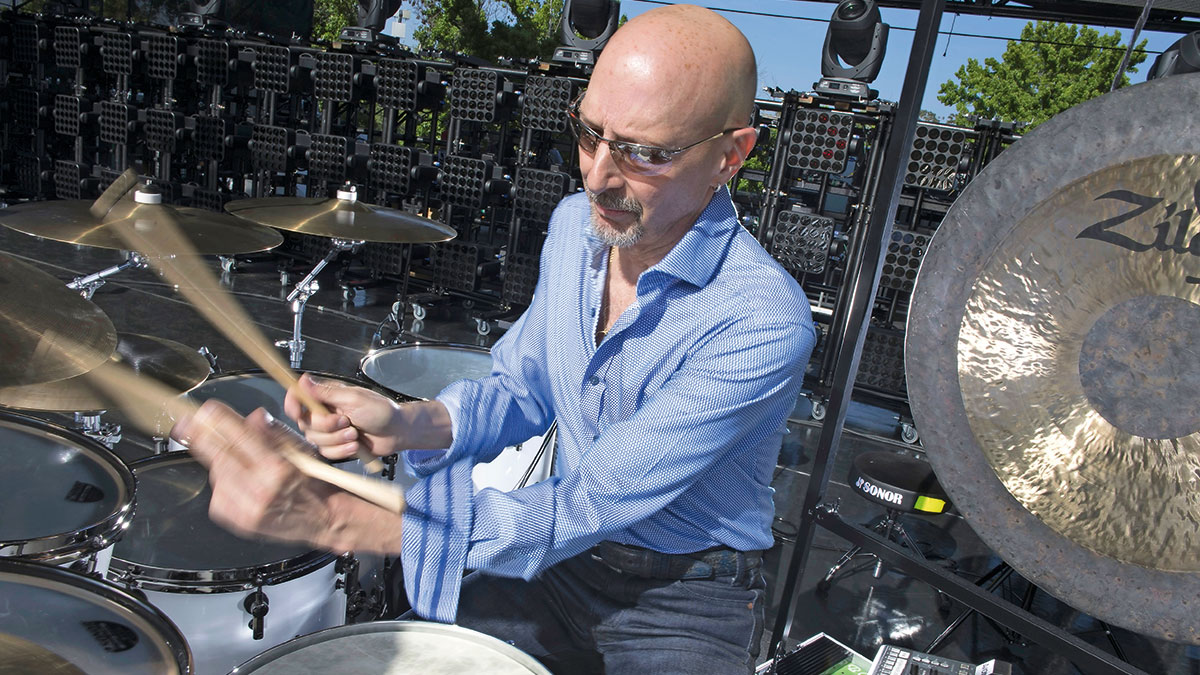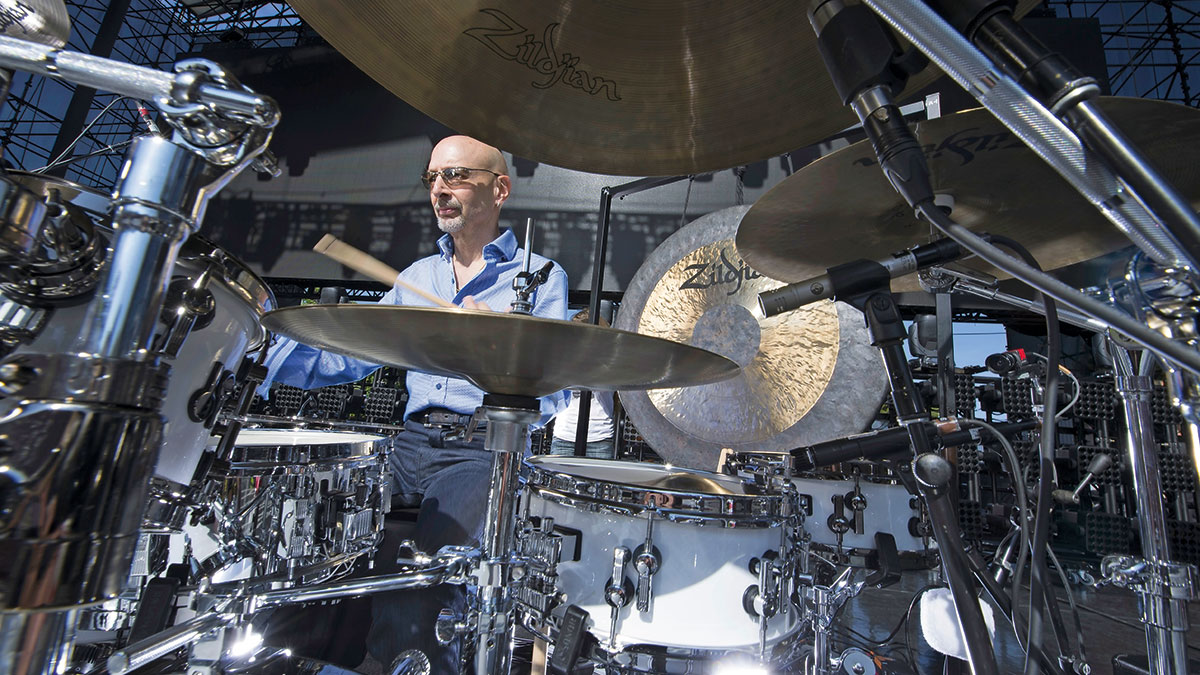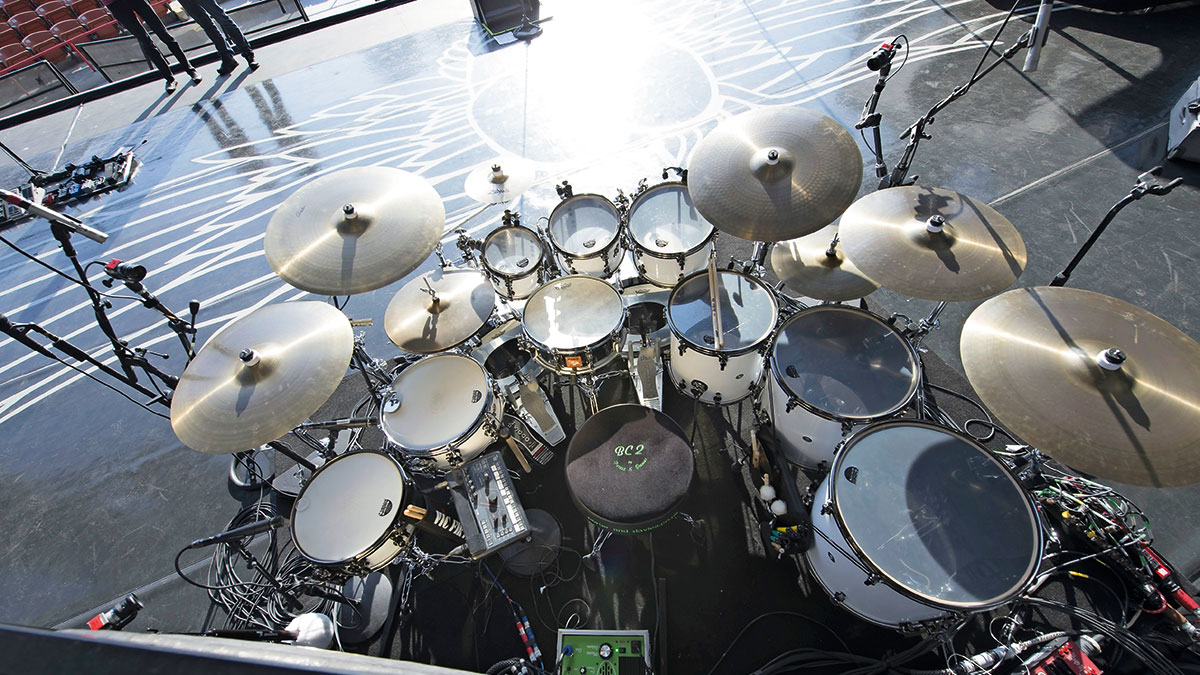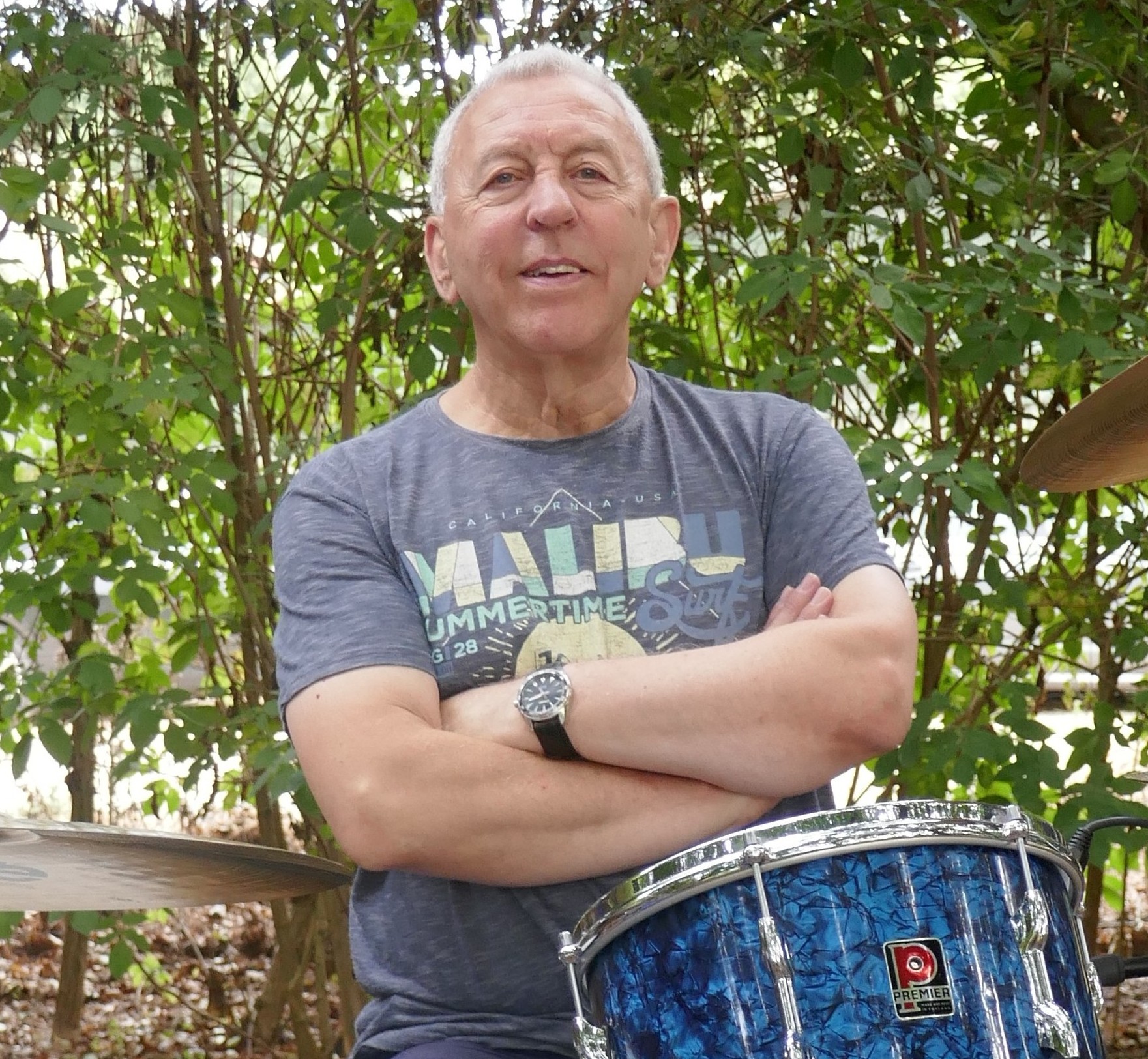Journey's Steve Smith on his amazing trip from jazz to rock
Drum legend talks getting back in the saddle with soft rock icons

From Journey to jazz... and back again
When we catch up with Steve Smith he’s in Cologne, Germany for a week performing and recording with his jazz fusion outfit Steps Ahead and the WDR big band.
And yet just days before he’s played New York’s Madison Square Garden during his first return dates with his old partners in the classic 1980s rock band Journey. We arrange to talk again a few days later, as soon as he’s back home in New York where he has a rare couple of days’ downtime to prepare for the massive Journey summer tour, revisiting his rock star role after half a lifetime.
Steve explains, “They’ve been asking me to do it for a long time and at this point I am 61 years old and still in good enough shape. I figured I’d better do it now and not wait a few more years!”
I still have a lot of jazz gigs booked this next year and I don’t intend to give that up.
It’s always been a great story. one of the leading jazz and fusion drummers of the modern era was once an integral member of the Don’t Stop Believin’ arena-filling power-balladeers. Journey was a prime mover in the era that spawned Boston, Foreigner, Toto and Van Halen.
All bands with post-Robert Plant constricted-trousered vocalists, backed by musicians several cuts above the average rocker. Journey’s Steve Perry was arguably the best singer of his generation, with his pure soaring vocals, dubbed ‘the Voice’ by Jon Bon Jovi.
Guitarist Neal Schon with Jonathan Cain [keyboards] and Ross Valory [bass] kept Journey going with replacement singers struggling to fill the void created by Perry leaving in 1987. Since 2007, Arnel Pineda, a YouTube sensation discovery, has admirably occupied Perry’s shoes.
Steve Smith departed a couple of years before Steve Perry, having played on most of their greatest hits. He did revisit Journey briefly a decade later for Trial By Fire, but now Steve Smith is back with Journey.
Although a Berklee alumnus, already highly trained and in thrall to jazz, Smith found himself in an intriguing situation in September 1978. Aged 24 he was touring with guitarist Ronnie Montrose supporting Journey when they asked him to join, replacing the UK’s Aynsley Dunbar.
For almost seven years Steve lived the major-league rock star’s life, playing on multi-platinum albums and touring 50,000-seater arenas. Even better, the band was a collective and Steve was cut into the writing. However, he always knew his heart and destiny lay in jazz and in 1985 ‘musical differences’ led to the drummer’s exit. By now he had the ability and reputation to pursue the career he always intended.
In this he may be unique. Other great jazz-fusion drummers like Steve Gadd and Vinnie Colaiuta combine top jazz gigs with major rock tours, but as sidemen rather than actual band members. “So it is pretty unique, my place in all of this!” Steve muses with a laugh. “But I still have a lot of jazz gigs booked this next year and I don’t intend to give that up. Right now I’m in Germany recording with Steps Ahead and the WDR big band. Michael Abene has written 10 great charts of Steps Ahead tunes – and the whole band is here with Tom Kennedy [bass], chuck Loeb [guitar], Bill Evans [sax] and Mike
Mainieri [vibes]. We recorded an album over the last three days and we’re going to play some jazz festivals in Germany this week.”

Journey revisited
It seems Steve has more on than ever. And yet here he is devoting the summer to rock touring. So, Steve, an explanation please...
"Well, for years I have been getting calls to see if I was interested in coming back. And I really was not, because I have a complete career as a band leader and featured side-man. I was not going to stop that to become a full-time member of Journey, which is what they were asking. Creatively, it’s interesting for me to visit, but it would not be satisfying long-term.
“So I’ve always said no. But last June, 2015, a unique opportunity came along when long-time drummer Deen Castronovo was let go because of personal problems. So they asked me and I was on tour with mike stern – essentially I had a whole year of bookings. So I said what if I tour next summer?
"But because they do two-year cycles – one year heavy touring and a second of lighter touring – we agreed I would make a two-year commitment. so 2016 is heavy and 2017 less so.”
I didn’t remember the original parts I played at all.
‘Heavy’ is an understatement. Steve is looking at 55 dates by September and admits, “I haven’t toured like that since the last time I toured with Journey – and that was 32 years ago!”
As the drummer on most of Journey’s biggest hits, fans will relish hearing him recreate those archetypal parts. However, he admits, “I didn’t remember the original parts I played at all. So I went back and wrote detailed transcriptions – I figured it would be best to hit ‘reset’!
"My approach is to play the tunes the way they sound best, adhering to what we did on the original recordings as a solid starting point. So I learned it all verbatim and practised a lot to memorise it. That is a key part of making the music work. When we played those tunes live in the 1980s we played them faster than the original recordings.
"That happens over time when you get a little tired of playing the same tunes every night, so you make them more exciting by playing them a little faster. That is one reason. The other is that Steve Perry wanted us to play them faster so he didn’t have to hold those [unfeasibly high vocal] notes so long! But now the group has got into the habit of playing the tunes very close to the original tempos, so they actually sound bigger, more majestic.”
Looking back at 1980s live videos, Steve was really walloping the kit. “I was playing pretty loud back then, hitting the drums hard, holding the sticks way at the back end – not really a good fulcrum, not getting a nice balance.”
Today Steve’s advanced technical skills compensate for all that youthful energy. In fact he’s been working on his left-hand matched grip and has a book/DVD out, Pathways Of Motion.
“It has absolutely helped me do a better job with Journey. I have lots more options of how to play the songs with open-handed and matched grip playing. And then I still use traditional a lot. I used traditional grip back then, but it is a lot better now. I am getting a full sound and as much energy as I need without hurting myself or beating up the kit. I don’t dent heads or break sticks.
“I came to rehearsals with my Sonor SQ2 kit...and they looked at it like, what’s up with the toy drumset?!"
"Originally I played Don’t Stop Believin’ and a couple of other songs open-handed. But now I have learned to play all the tunes open-handed, I can play them open-handed, traditional or matched grip. I have lots of options so my hands don’t get tired and I find that by switching between them I can play a 90-plus-minute set and feel fine, with no adverse effects.”
Another big change is the jump from double bass-drum pedal to double bass-drums. “I originally came to rehearsals with my Sonor SQ2 kit I have been using for 10 years, with a single bass drum, three rack toms and two floors and they looked at it like, what’s up with the toy drumset?! Whereas in the jazz world that is a big drumset.
"So I said alright, I guess I need the obligatory double bass-drums. And actually it was an easy adjustment. I like the feel of the two bass drums, the angle of the pedals. I like to sit at the drums in the most natural way and have a bit of an angle with both feet. with the single bass drum straight-on it is harder.
“I had been experimenting with three floor toms, especially playing with Hiromi and recreating the parts that Simon Phillips had recorded. I started using a third floor tom, super-low.”
There’s still the physical exertion though, coming back to stadium rock 30 years older?
“I prepared myself. I did a lot of practising before even the first rehearsal. I still have my 1980s double bass-drum set, but I hadn’t played it since then and so I practised on that a couple of hours a day. I always try to stay in good shape, but I made an extra effort. I do a lot of yoga.”
Presumably that’s now part of the modern game, if you want to keep rockin’ till you’re 80... “Yeah, well nobody thought we’d be playing rock’n’roll in our sixties and seventies, but people are doing it now! We are playing anywhere from 10 to 15,000 seaters every night. My first gig was Madison Square Garden. Our last gig is [the 41,000 seater] AT&T Park in San Francisco on September 4th with Santana, the Doobie Brothers, Steve Miller and Tower of Power – a big stadium!”

The fabric of rhythm
Along with several other high profile drummers, Steve has recently collaborated with LA art collective SceneFour in producing pictures created via playing solos with lighted drumsticks in a dark room using time-lapse photography and then transferring the images onto canvas.
Somewhat incredulously, Steve says, “I recently had an art show in NYC which was fascinating for me, very novel! When I did the art project three years ago it was a standalone project, but SceneFour had the idea of making a coffee table book with the images and that seemed like a good opportunity to make a solo record.”
Ah, yes. As someone always striving to forward the art of solo drumming, here was the ideal vehicle. “I had 13 canvasses and I thought what if I dedicate a solo for each piece and include that with the book on a vinyl LP. In fact I had 14 solos so the album has seven tracks on each 23-minute side. It’s called the Fabric of Rhythm and I’m thrilled with it.”
The first time we ever saw Steve he performed Max Roach’s The Drum Also Waltzes and Billy Cobham’s Quadrant 4. On Vital information’s 2015 album Viewpoint there is an affectionate and brilliant reworking of Joe Morello’s seminal Take Five solo.
I had the good fortune to see Max Roach perform a solo concert at the San Francisco Jazz Festival and it really changed my perspective of musicality on the drumset.
So it comes as no surprise when Steve reveals, “I’ve had it in mind to make a drumset solo album for years. Ever since Jack DeJohnette released Pictures in 1976 with mostly solo drumset pieces. It convinced me it could be done, even back then. Then recently Antonio Sanchez did the soundtrack for [movie] Birdman and I can listen to that over and over. Every one of his solos makes such a statement.”
So, of the Fabric of Rhythm, Steve says, “They are pieces I’ve been working on and playing live and I figured out how to adapt them. It was recorded in a large church [Foundation Soundstage, Ashland, Oregon] with no artificial reverb, just a beautiful big sound. It will be released with the book, 250 limited-edition numbered and signed copies in August.” You can see all the canvasses at www. stevesmithdrumart.com along with Steve’s notes on the artworks and the solos inspired by them. Although the limited edition is perhaps for minted fans, Steve says there will be a code to download the solos.
"Some of the pieces are directly inspired by the art – eg: Zen Roll is strictly a roll on a snare drum with a cymbal on the batter to get that modern electric machine sound. others are more abstract.”
The eerie Cymbalic Alchemy, for example, sees Steve, “Playing the cymbals with a stick in one hand and putting the mic right up to the cymbal edge.”
Other tracks display Steve’s phenomenal ability, but always with a musical point. Anyone who’s seen Steve live in recent years will know he’s dug deeply into the Indian vocal form Konnakol and is able to vocalise ever-more expressively as he accompanies himself on the kit. It confers structure and melody to his solos.
“That is becoming more of my vocabulary. I incorporated Konnakol in four of the pieces. Kinetic Dance is a really challenging one. I have worked on that a lot, so I can play those tihais [concluding rhythmic figures] any time I want while I am improvising. I came up with a piece in order to practise that idea.”
On Infinity Knot Part 1 Steve plays the rhythms of the overtone series from one through 12. “When you hear a note the overtones always follow the exact same pattern. First you hear the fundamental and then you hear an octave, which is twice as fast, and then you hear a perfect fifth above that, which is one third faster. So first you get one, and then you get two-over-one and then you get three-over-two-over- one, and the next thing you hear is a fourth above that which is actually another octave from the original fundamental, so that is four-over-three. Then I keep the three-over-two in my feet, and continue with five over that, six through to 12 and then 12 all the way back down again.”
Although it’s revealing to read the technical explanation while listening, the solo is far more melodically engaging than the cold mathematical description suggests. You wonder if Steve should, as Terry Bozzio did a few years ago, perform solo concerts with these pieces?
"Well that’s a good question. I don’t know. I have done some solo concerts, and find them fun. I had the good fortune to see Max Roach perform a solo concert at the San Francisco Jazz Festival and it really changed my perspective of musicality on the drumset.
"His solos were a big inspiration for my solos having some kind of hook and recognisable melody and rhythm. But then he took a snare drum out front and played an entire piece with brushes and then he played Mr Hi-Hat for solo hi-hat. I have done those as well, learned how to play standalone brushes and snare drum, and standalone hi-hat. and when I saw Max at San Francisco’s Palace of Fine Arts there were a thousand people there and they loved it.”

Steve's Gear
Drums
Sonor Steve Smith SQ2 kit in White Solid Lacquer High Gloss with Black Chrome hardware:
2 x 22"x14" bass drums with Vintage beech shells and modern bearing edges
Medium Maple toms; 3 x rack toms: 8"x7", 10"x8", 12"x9"; 3 x floor toms: 14"x14", 16"x16", 18"x16"
Three snare drums: 14"x51⁄2" Steve Smith Signature metal; 14"x53⁄4" Vintage beech shell and vintage bearing edges and rims with modern hardware; 12"x5" medium maple side snare; Puresound snare wires
Cymbals
Zildjian New Avedis line (l-r) 19", 22" with three sizzles. 15" hi-hats, 10" Flash Splash (new splash designed with Peter Erskine); 22", 14" X-Hats, 18", 20"; White Cympad Cymbal Optimisers; 34" Zildjian Gong
Plus
Remo heads – kick: Clear Powerstroke-3 with Black Dots; main snare: FyberSkyn Diplomat batter; two additional snares: White Rough Coated Ambassador batters; tom heads: Clear Ambassador batters; Vic Firth Steve Smith Signature model sticks; DW Titanium bass drum pedals; DW hi-hat pedal; Porter & Davies drum throne; Sensaphonics 3D Active Ambient In-Ear Monitors

Geoff Nicholls is a musician, journalist, author and lecturer based in London. He co-wrote, co-presented and played drums on both series of ‘Rockschool’ for BBC2 in the 1980s. Before that he was a member of original bands signed by Decca, RCA, EMI and more. ‘Rockschool’ led to a parallel career writing articles for many publications, from the Guardian to Mojo, but most notably Rhythm magazine, for which he was the longest serving and most diverse contributor.